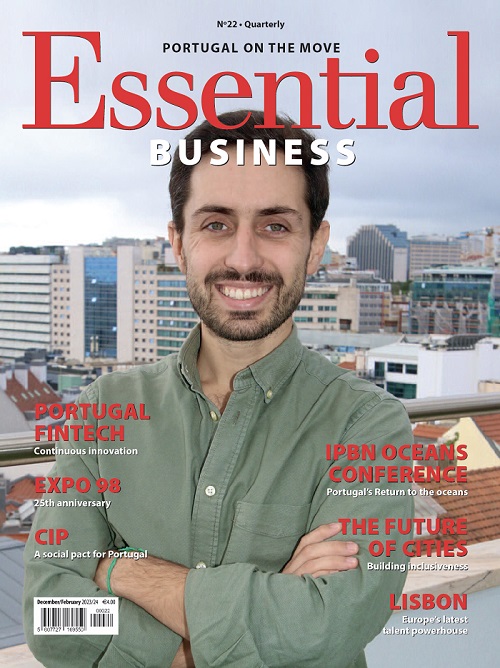Building bridges between Portugal and Romania
Initially, you wouldn’t think Ioana Bivolaru was a seasoned ambassador. Quiet and reserved, she speaks in a hushed but steady voice. The Romanian ambassador to Lisbon, who arrived in 2016, is timid about being photographed despite her evident beauty and classic and impeccable dress sense. And then you see her curriculum: stints in Brussels as Director-General of the Foreign Affairs Department of the European Union and dedicated to the European project. A linguist, she speaks Italian, English and is learning Portuguese, a language she already adores.
One of 17 female Romanian ambassadors around the world, Ioana Bivolaru is also one of 24 female ambassadors in Portugal.
“Here, there’s a very strong Association of Women Ambassadors (AWA). It has the largest number of women chief of missions in Europe and we celebrated International Women’s Day (March 8). We are very active, and President Marcelo Rebelo de Sousa is very much in favour of gender equality; it’s a key objective for his mandate,” she says.
Under the President’s patronage, the AWA is organising an international conference to raise awareness on women’s issues and empowerment. Another conference will be held in May on digital transformation and its impact on women.
Cooperation on startups
“Portugal is in the vanguard regarding startups, digital technology and transformation, and this is something we’re interested in,” says the ambassador. “We had a big event on April 18 in Porto with our deputy minister of entrepreneurship, Gabriela Mihaela Voicila who signed a cooperation and exchange accord in the startups and digital field in the presence of Nicolae Robu, Mayor of Timisoara [Timisoara is European Capital of Culture in 2021] and Rui Moreira, Mayor of Porto; a business forum involving over 70 companies organised by the Timisoara Chamber of Commerce and the Portuguese Foreign Investment Agency AICEP, AEP (Portuguese Entrepreneurial Association) and ACP (Porto Commercial Association); the inauguration of Romania’s new honorary consulate in the city; and a classical music concert in Clérigos.”
100 years of Portuguese-Romanian relations
“I felt very privileged being here when Portugal and Romania celebrated the centenary of bilateral relations in 2017. This year we also celebrate the Romanian Centenary [December 1, 1918] of the unification at the end of WWI of all provinces where Romanians held the majority [Transylvania, Banat, Crisana, Maramures, Bukovina and Bessarabia]. It’s also our National Day.”
She tells me Romania has the fourth largest expat community in Portugal after Brazil, Cape Verde and Ukraine, while Portugal has one of the largest community of Romanians in a EU member state.
“The 30,000 Romanians living in Portugal are extremely well integrated. Most live around Lisbon and Setúbal, with concentrations in the Algarve and Aveiro. We meet sections of the community on a regular basis and they’re very involved in embassy events,” she says.
“Culture unites peoples, which is why last year we marked the centenary of our relations with Portugal with a year-long programme of events and initiatives organised by the Romanian Cultural Institute and the Romanian embassy in Lisbon entitled ‘12 Chapters of Romanian Creativity in Portugal’.”
This resulted in the 12 Chapters programme, the aim of which was to raise Portuguese public awareness about Romanian creativity, both contemporary and historic, with programmes like ‘A Century of Romanian Cinema’ at the Cinemateca Portuguesa; ‘Lisbon reads Romanian’, a reading marathon of Romanian authors translated into Portuguese; the unveiling of ‘The Middle Way’ monument by artist Bogdan Rata in Cascais; and the FIKL painting exhibition ‘Portuguese Storylines’ at the Palácio Nacional da Ajuda, among others.
“The centenary commemoration celebrations were crowned by the publication of a bilingual book Romania – Portugal: 100 Years Since the Establishment of Romanian-Portuguese Diplomatic Relations in which the most relevant names and events over the century are highlighted,” she continues.
Strong dynastic ties
I am also informed of the strong historical ties between both countries’ royal dynasties. In the exhibition ‘Royal and Noble Romania’, which ran in Lisbon last year, the early 20th-century close royal ties between the two countries were explored, with particular emphasis on Queen Marie of Romania (1914-1927), the beloved and controversial queen of Ferdinand I of Romania (whose mother was Princess Antónia of Braganza). She was considered by the greatest Portuguese traveller of the 20th century, Fernando Reis, who met her, “the most beautiful queen of all time”.
A golden opportunity to open windows
Ioana Bivolaru says she likes to organise large events, like the one currently running at Lisbon’s National Museum of Archaeology, ‘Ancient Gold from the Black Sea to the Atlantic Ocean’.
“Portugal and Romania are not only linked by a common Latin culture; they are both territories with ancient civilisations interested in mining gold and silver, and fashioning it into jewellery. Gold from Romania (Dacia during the Roman period) and Portugal (Lusitania) establish a bridge linking historic and regional particularities as common elements in goldsmithery.
“It’s interesting to see the enameled rings from that time from both cultures which are strikingly similar. My job here is to open a window on Romania since my country is not that well known in Portugal and this exhibition reveals similarities.”
A westward-looking foreign policy
The ambassador admits Romania is in a challenging region, in challenging times. Despite being in the Warsaw Pact under Soviet hegemony after WWII, Romania has had to play a delicate balancing act between maintaining friendly relations with Russia to the east while actively pursuing a westward-looking foreign policy.
Since the fall of the Ceausescu regime in 1989, Romania has pursued a policy of strengthening relations with the West in general and more specifically with the United States and the European Union, while retaining friendly relations with Russia.
It joined the North Atlantic Treaty Organisation (NATO) on March 29, 2004, the European Union (EU) on January 1, 2007 and had already been a member of the International Monetary Fund and the World Bank since 1972. It is also a founding member of the World Trade Organisation.
The current government has stated its goal of strengthening ties with other countries (in particular Moldova, Ukraine and Georgia) and helping them with the process of integration with the rest of the West. Romania has also made clear, since the late 1990s, that it supports NATO and EU membership for the democratic former Soviet republics in Eastern Europe and the Caucasus.
“European integration and transatlantic relations are important aspects of our foreign policy as is promoting regional stability with our neighbours,” Ioana Bivolaru stresses.
Portugal-Romania bilateral relations
Bilateral trade between the two countries stands at almost €700 million. “We are at the peak of our economic relations which have consistently enjoyed an upward trajectory with a 10% increase in trade.”
With a strong Romanian presence at Web Summit last year and a number of startup incubators in Bucharest and other main cities, Romania is keen to draw on Portugal’s experience in this area.
Romanians are “very creative” and despite an under-funded and fragmented environment, Romania’s tech sector is “growing fast” with new investment funds and business angles supporting more and more tech-based startups.
There is also trade in agro-chemical products and automotive components. “We are looking for new areas for growth and there is potential for cooperation between the two countries in tourism. This area has developed, too, in Romania thanks to direct flights from Portugal. Romania hopes to draw on Portugal’s wide and developed experience in tourism and we’ve even signed an agreement in hospitality training,” says the ambassador.
“We export agricultural products, fertilisers, cereals, textiles and components to Portugal and there are 600 Portuguese companies doing business with us, with an active Romanian-Portuguese Chamber of Commerce based in Estoril organising business forums,” she adds.
Portuguese firms in Romania
Portugal’s retail real estate sector is particularly successful in Romania with Sonae Sierra developing shopping centres, including one of the largest malls in central and eastern Europe, ParkLake (Bucharest), representing a €180 million investment.
In terms of energy and metal engineering, EDP and Martifer (bridges) have ongoing projects in the country. EDP company EDPR has had a subsidiary in Bucharest since 2008 with several wind projects at different stages of maturity. In 2010, EDPR completed the construction of its first project in Romania – Pestera – completing 90 MW out of the current 521 MW of installed capacity. In 2013, EDPR’s first solar power plant (50 MW) came on line. There are also several medium-size Romanian construction companies operating in Portugal.
Language similarities
Ioana Bivolaru loves to explore the similarities of proverbs, words and expressions between Portuguese and Romanian. There are some words, like “to boil” (ferver) which is similar to the same word in Romanian (fierbe) and yet the other Latin languages didn’t retain it, although in English the word “fever” (febre) surely derives from the Latin.
“We are the only country in Europe that has a word that expresses the Portuguese idea ‘saudade’ with our word ‘dor’ (which in Portuguese actually means ‘pain’).” And one of her personal favourite expressions, “Cu um kil de carne si un litru de vin nu se moare de foame” (with a kilo of meat and a litre of wine you won’t die of hunger), is incredibly similar to Portuguese (Com um quilo de carne e um litro de vinho não se morre de fome). A curious and interesting link between the two Latin languages.










